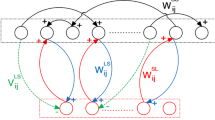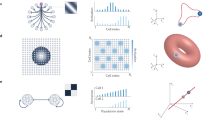Abstract
We study an Attractor Neural Network that stores natural concepts, organized in semantic classes. The concepts are represented by distributed patterns over a space of attributes, and are related by both semantic and episodic associations. While semantic relations are expressed through an hierarchical coding over the attribute space, episodic links are realized via specific synaptic projections. Due to dynamic thresholds expressing neuronal fatigue, the network's behavior is characterized by convergence toward the concept patterns on a short time scale, and by transitions between the various patterns on a longer time scale. In its baseline, undamaged state, the network manifests semantic, episodic, and random transitions, and demonstrates the phenomen of priming. Modeling possible pathological changes, we have found that increasing the ‘noise’ level or the rate of neuronal fatigue decreases the frequency of semantic transitions. When neurons characterized by large synaptic connectivity are deleted, semantic transitions decay before the episodic ones, in accordance with the findings in patients with Alzheimer's disease.
Similar content being viewed by others
References
Abbott LF (1990) Modulation of function and gated learning in a network memory. Proc Natl Acad Sci USA 87:9241–9245
Adams RD, Victor M (1989) Principles of neurology. McGraw-Hill, New York
Amit DJ (1989) Modeling brain function: the world of attractor neural networks. Cambridge University Press, Cambridge
Anderson JR (1976) Language, memory, and thought, Erlbaum, Hillsdale
Andersson JR (1985) Cognitive psychology and its implications. W. H. Freeman and Company, New York
Bertoni-Freddari C, Fattoretti P, Casoli T, Meier-Ruge W, Ulrich J (1990) Morphological adaptive response of the synaptic junctional zones in the human dentate gyrus during aging and Alzheimer's disease. Brain Res 517:69–75
Bok ST (1959) Histonomy of the cerebral cortex. Elsevier, Amsterdam.
Carpenter GA, Grossberg S (1990) Art 3: Hierarchical search using chemical transmitters in self-organizing pattern recognition architectures. Nerual Networks 3:129–152
Collins A, Loftus E (1975) A spreading activation theory of semantic processing. Psychol Rev 82:407–428
Collins AM, Quillian MR (1969) Retrieval from semantic memory. J Verb Learn Behav 8:240–247
DeKosky ST, Scheff SW (1990) Synapse loss in frontal loss in frontal cortex biopsies in Alzheimer's diease: Correlation with cognitive severity. Ann Neurol 27(5):457–464
Fahlman S (1981) Representing implicit knowledge. In: Hinton GE, Anderson JA (eds) Parallel models of associative memory. Erlbaum, Hillsdale
Feigelman MW, Ioffe LB (1987) The augmented models of associative memory asymmetric interaction and hierarchy of patterns. Int J Mod Phys B 1:51–68
Fuster J (1990) Inferotemporal units in selective attention and short term memory. J Neurophysiol 64:681–697
Georgopolous AP, Kettner RE, Schwartz AB (1988) Primate motor cortex and free arm movements to visual targets in three dimensional space. II. Coding of the direction of movement by a neural population. J Neurosci 8:2928–2937
Granholm E, Butters N (1988) Associative encoding and retrieval in Alzheimer's and Huntington's disease. Brain-Cogn 7(3):335–347.
Gröbler T, Marton P, Erdi P (1991) On the dynamic organization of memory. Biol Cybern 65:73–79
Gutfreund H (1988) Neural networks with hierarchically correlated patterns. Phys Rev A 37:570–577
Hasselmo ME, Bower JM (1992) Chlorinergic modulation of cortical memory function. J Neurophysiol 67:1230–1246
Heit G, Smith ME, Halgren E (1988) Neural encoding of individual words and faces by the human hippocampus and amygdala. Nature 333:773–775
Herrmann M, Tsodyks M.V. (1991) Pattern hierarchy destruction in nonlinear neural networks. Workshop on Neural Networks in Biology and High Energy Physics, Isola d'Elba, 1991
Hinton GE (1981) Implementing semantic networks in parallel hardware. In: Hinton GE, Anderson JA (eds) Parallel models of associative memory. Erlbaum, Hillsdale
Hoffman RE (1987) Schizophrenia-mania dichotomy. Arch Gen Psychiatry 44:178–191
Hoffman RE, Dobscha S (1989) Schizophrenia Bull 15(3):477–489
Horn D, Usher M (1989) Neural networks with dynamic thresholds. Phys Rev A 40:1036–1044
Horn D, Usher M (1990) Excitatory-inhibitory networks with dynamical thresholds. Int J Neural Syst 1:249–257
Hyman BT, Van Hoesen GW, Damasio AR, Barnes CL (1984)Science 225:1168–1170
Kihlstrom JF (1987) The cognitive unconscious. Science 237:1145–1152
King R, Barchas JD, Huberman BA (1984) Chaotic behavior in dopamine neurodynamics. Proc Natl Acad Sci USA 81:1244–1247
Kleinfeld D (1986) Sequential state generation by models of neural networks. Proc Natl Acad Sci USA 83:9469–9473
Mamelak AD, Hobson JA (1989) Dream bizarreness as the cognitive correlate of altered neuronal behavior in REM sleep. J Cogn Neurosci 1(3):201–221
Marcel AJ (1983) Conscious and unconscious perception: an approach to the relations between phenomenal and perceptual processes. Cognit Psych 15:238–300
Miller EK, Li L, Desdimone D (1991) A neural mechanism for working and recognition memory in inferior temporal cortex. Science 254:1377–1379
Posner MI, Petersen SE, Fox PT, Raichle ME (1988) Localization of cognitive operations in the human brain. Science 240:1627–1631
Ratcliff R, McKoon G (1981) Does activation really spread? Psychol Rev 88:454–462
Ritter H, Kohonen T (1989) Self-organizing semantic maps. Biol Cybern 61:241–254
Rosh E, Mervis C (1975) Family resemblances: studies in the internal structure of categories. Cogn Psych 7:573–605
Rumelhart DE, McClelland J (1986) Parallel distributed processing. MIT Press, Cambridge
Sakay K, Miyashita Y (1990) Neural organization of the long term memory of pair associates. Nature 354:152–159
Salmon DP, Shimamura AP, Butters N, Smith S (1988) Lexical and semantic priming deficits in patients with Alzheimer's disease. J Clin Exp Neuropsychol 10(4):477–94
Schacter DL (1989) Memory. In: Posner MI (eds) Foundations of ognitive science. MIT Press, Cambridge, pp 683–708
Servan-Schrieber D, Printz H, Cohen JD (1990) A network model of cathecholamine effects: gain, signal-to-noise ratio, and behavior. Science 249:892–895
Skarda CA, Freeman WJ (1987) Does the brain make chaos in order to make sense of the world. Behav Brain Sci 10:161–165
Smith E, Shoeben E, Rips LJ (1974) Structure and process in semantic memory: a featural model for semantic decisions. Psych Rev 81:214–232
Smolensky P (1986) Neural and conceptual interpretation of PDP models. In: Rumelhard DE, McClelland J (eds) Parallel distributed processing. MIT Press, Cambridge, pp 390–431
Sompolinsky H, Kanter I (1986) Temporal associations in assymetric networks. Phys Rev Lett 57:2861–2864
Squire LR (1982) The neuropsychology of human memory. Ann Rev Neurosci 5:241–273
Sutton JP, Mamelak AN, Hobson JA (1992) Modeling states of waking and sleeping. Psychiatr Ann 22(2):1–7
Swindale NV, Vital-Durand F, Blakemore C (1981) Recovery from monocular deprivation in the monkey. Reversal of anatomical effects in the visual cortex. Proc R Soc Lond Sec B. 213:435–450
Tanaka K, Saito Y (1991) Coding visual images of objects in the inferotemproal cortex of macaque monkey. J Neurophysiol 66:170–189
Terry RD, Peck A, Teresa R, Schechter R, Hyoroupian DS (1981)Ann Neurol 10:184–192
Treisman A, Gelade G (1980) A feature-integration theory of attention. Cogn Psychol 12:97–136
Tsodyks MV (1990) Hierarchical associative memory in neural networks with low activity level. Mod Phys Lett B 4:259–265
Tulving E (1985) How many memory systems are there? Am Psychol 40:385–398
Author information
Authors and Affiliations
Rights and permissions
About this article
Cite this article
Herrmann, M., Ruppin, E. & Usher, M. A neural model of the dynamic activation of memory. Biol. Cybern. 68, 455–463 (1993). https://doi.org/10.1007/BF00198778
Received:
Accepted:
Issue Date:
DOI: https://doi.org/10.1007/BF00198778




